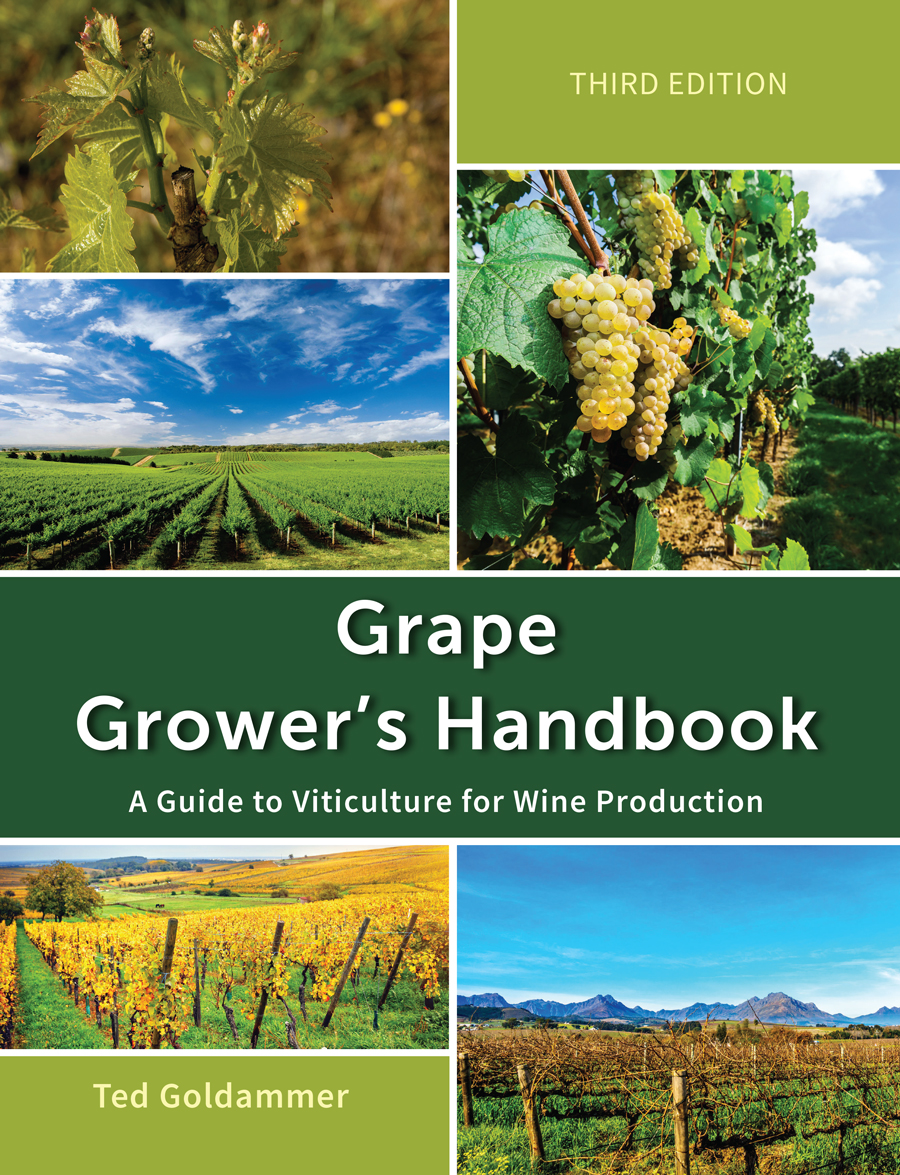Annual Growth Cycle of the Grapevine
Grapevine Structure and Function
The grapevine is a woody perennial plant (See Figure 1.1), which is differentiated into the above ground shoot system (e.g., trunk, leaves, flowers, and fruit) and the underground root system.
Roots
The roots of a grapevine are multi-branched structures that grow to various depths into the soil and anchor the vine securely. Roots absorb water and nutrients from the soil, store carbohydrates and produce the hormones that regulate vine growth. The roots are typically multi-branching, producing lateral roots that further branch into smaller lateral roots. The majority of the grapevine root system is usually reported within 3 feet (0.9 m) of the soil. Different varieties of grapes have naturally different root growth patterns. Vitis riparia roots grow more vertically, while Vitis rupestris roots have more lateral growth.
Trunks
The trunk is the main stem, without the branches. Cordons are extensions of the trunk that usually grow horizontally as they are trained along a wire. Cordons can extend from the trunk in either one or two directions-called unilateral or bilateral. Fully developed, cordons can bear arms, spurs, base shoots and canes.
Buds
Buds are highly compressed shoots which are formed in the angle (axil) of leaves. A shoot produces many leaves during the season, each of which has an associated axillary bud. The structure of these buds is quite complex. One part of it grows immediately (the summer lateral), while other parts remain as the compressed, multi-branched system that make up the overwintering compound bud or "eye." This latter structure bears next season's crop.
Shoots
Shoots, the green stems which develop from primary buds, are the primary growth structure of grape vines. Tendrils, leaves, flower clusters that will mature into fruits, and more buds are arranged in regular patterns along the shoot. The shoot grows longer from the shoot tip, which never forms a terminal bud. Canopy is the collective term used to describe the shoots, leaves and fruit of grapevines. An internode is the part of a cane or shoot that is located between nodes. Laterals are the side branches of a shoot or cane.
Leaves
The leaves of the grapevine provide nourishment and air for the plant. The leaves grow laterally along the vine with three to five large lobes, which are serrated at the edges. Grapevine leaves are light to dark green in appearance. The leaves of any plant, grapevine included, are the main tool of nourishing the plant, converting sunlight into usable energy.
Tendrils
Tendrils-a distinct feature on grapevines-are long, winding protrusions which coil and wind around fences, trellises, the plant itself and anything else they may reach. Tendrils appear at the top and sides of stems, growing in long, thin lengths until the plant is ready for harvest. After the fruit is harvested, the tendrils of the grapevine will harden and become wooden in nature.
Flowers and Grapes
Flower clusters grow opposite leaves along the shoot. Most shoots develop one to three flower clusters; the name depends on the variety of grape vine and growing conditions when the bud was formed. Each cluster may contain only a few or up to several hundred flowers; the number depends on the variety and environmental conditions. When fertilized, the flower clusters develop into clusters of grapes.
Canes
Grapevine canes, by definition, are shoots that have reached about a year in age. By this time, the tender shoot has developed a visible bark layer and has dropped all or most of its leaves. Canes become "older wood" when their brownish, tight bark becomes a decidedly brown bark that attaches loosely to the wood and shreds easily due to the formation of a cork layer beneath it. The pith of a cane is also much easier to distinguish than in older wood. The cane is the principal structure of concern in the dormant season, when pruning is employed to manage vine size and shape, and to control the quantity of potential crop in the coming season. The main methods of grapevine training are cane systems and spur systems, but both methods involve training canes of various lengths, spurs being those trimmed to four or fewer buds.
Suckers and Watersprouts
Suckers often arise from latent buds at underground node positions on the trunk. In routine vine management, suckers are removed early in the season before axillary buds can mature in basal bracts of the sucker shoots. Similarly, above-ground suckers are typically stripped off the trunk manually so a pruning stub does not remain to harbor additional latent buds that could produce more suckers in the following year.
Click on the following topics for more information on the annual growth cycle of the grapevine.

